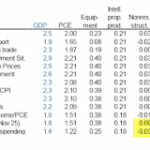With stocks falling today continuing somewhat yesterday’s post-FOMC sell-off there was going to be universal citation of monetary policy; or at least these new expectations of monetary policy coming supposedly for June. The dominant narrative remains in favor of Fed power where stocks don’t do well without it. So as the central bank removes so very slowly its “accommodation” we are led to believe that is the cause of equity price angst.
How this idea has survived the events of the past few years let alone since August 2007 is simply disgraceful. If there has been a “Greenspan put” all along how is it that the stock market crashed twice in the 2000’s? The four QE’s added up to $4.5 trillion on the asset side of the Federal Reserve balance sheet, but since June 2014 there have only been increasing and more intense indications of monetary shortage. The federal funds market is barely a market and in many ways ceased to exist in any meaningful fashion many years ago, yet the media treats a rise in the federal funds rate as synonymous with something relevant to actual markets.
On December 16, the day the FOMC voted for a “rate hike”, the CMT yield for the 2-year treasury note was 1.06%; for the benchmark 10-year it was 2.30%. As of today, including the bond market selloff of the past few days, the yield on the 2-year is 0.89% and just 1.85% for the 10s. Even taking into account one “rate hike” in between rates are across-the-board less now, and significantly so, than before it. I could go on in eurodollar futures and swap rates (and spreads).
Stocks around the world sold off on Thursday, while the U.S. dollar gained, pressuring oil and other commodities, as investors absorbed the possibility that the U.S. Federal Reserve will raise interest rates in the near term.
I highly doubt that investors in the core of the global system were at all bothered by the governmental show put on in Washington. It fills media content and may even make for good TV, but to believe anything more than that is defied by continuous observation spreading year after year after year. Rather than suggest that the Federal Reserve might be responsible for the recent inability of stocks to gain, it is much more likely that the dominant correlation across the world has reasserted itself. I don’t think it coincidence that markets struggled today of all days given that the PBOC fixed CNY to its lowest point since March 1. At just shy of 6.55, the exchange rate is threatening to press into the realm that has in the past proven beyond moderate global disruption.













Leave A Comment